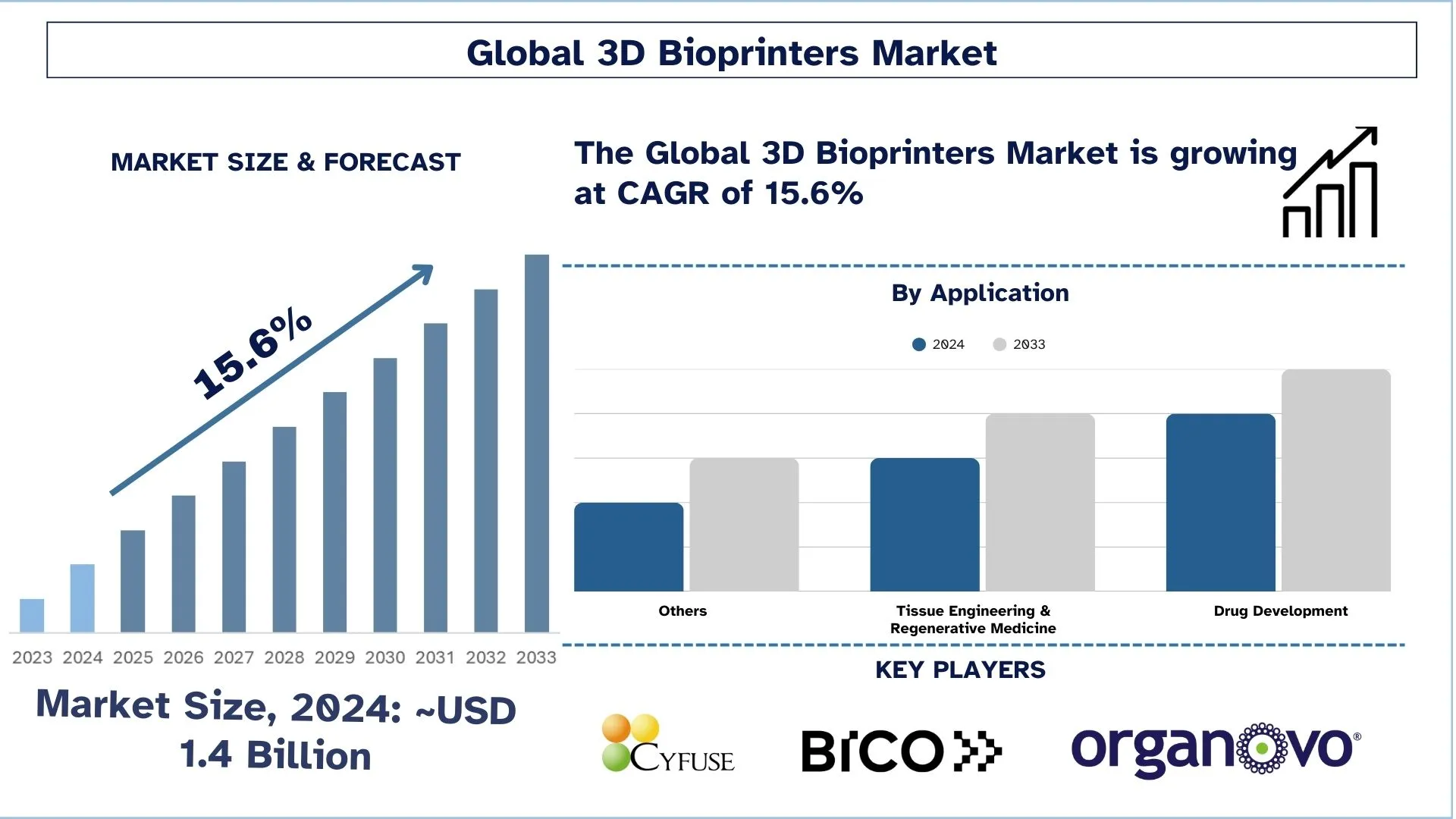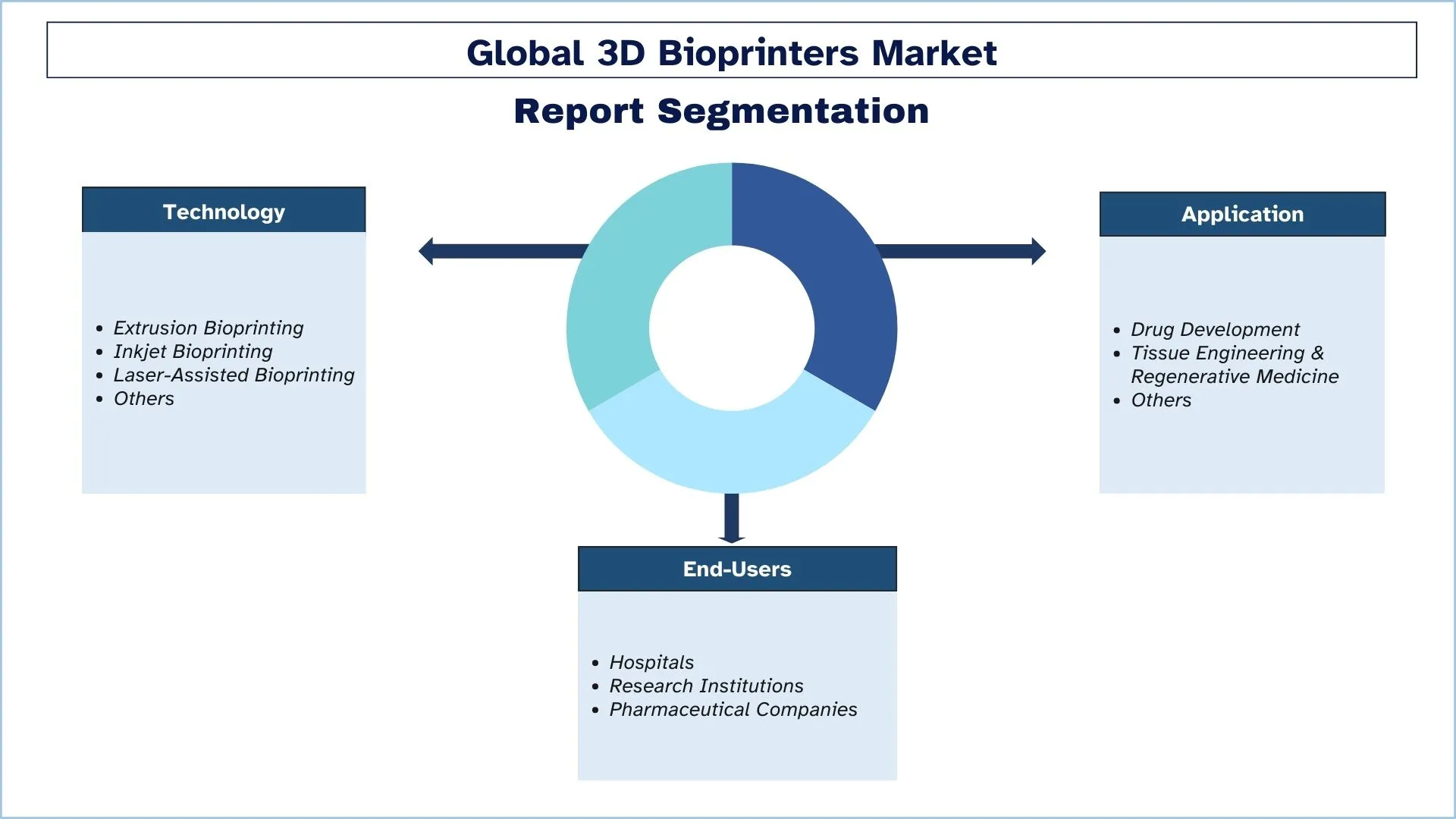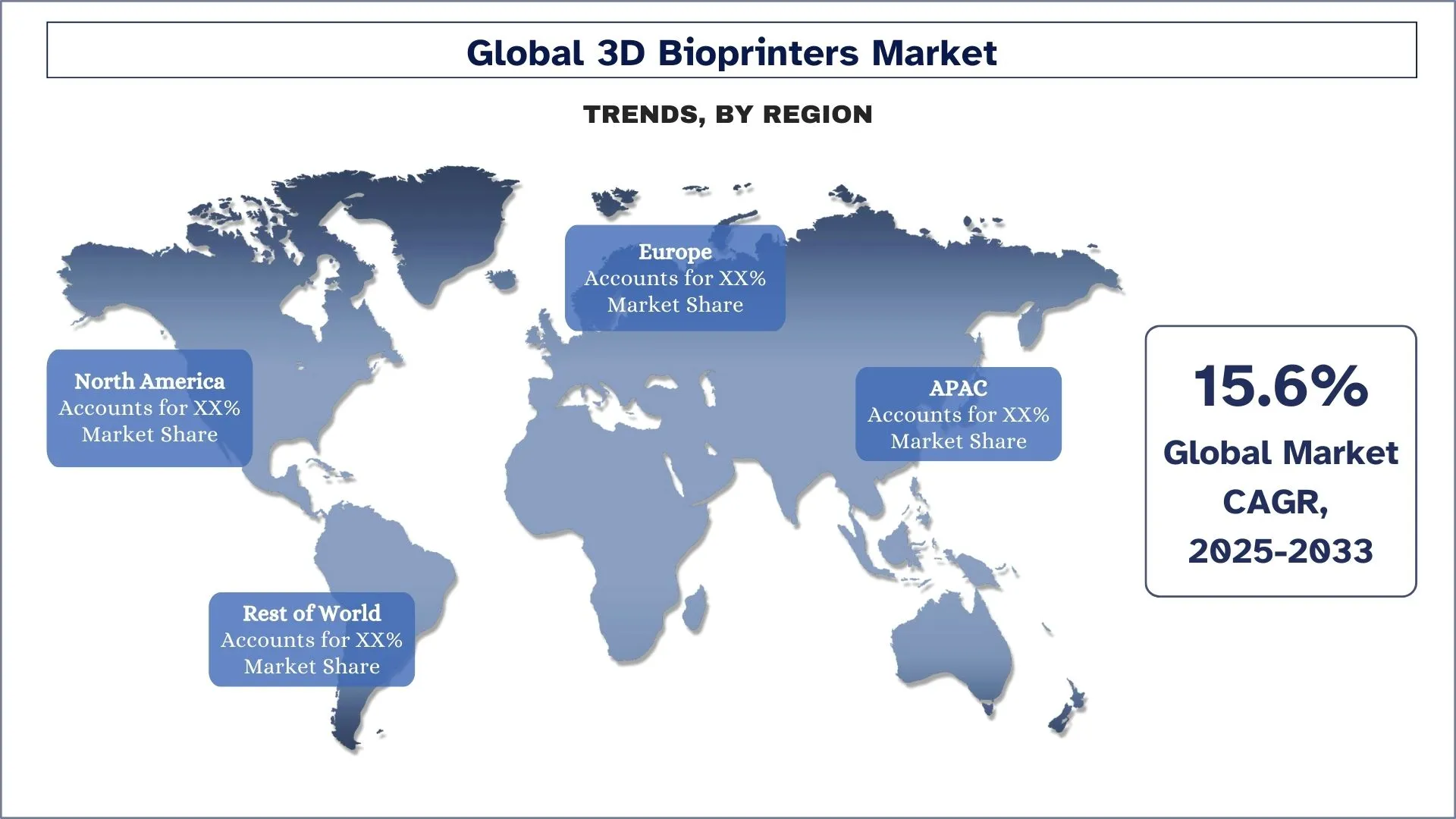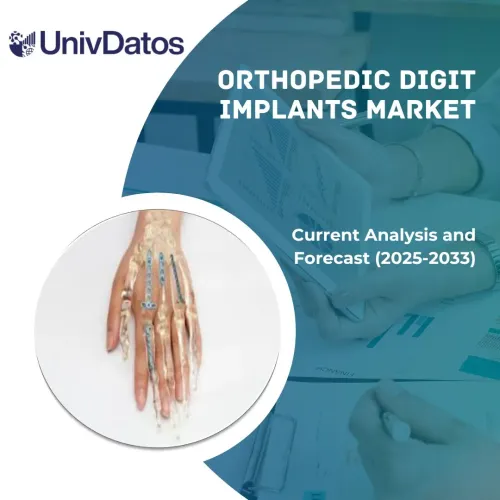- Startseite
- Über uns
- Industrie
- Dienstleistungen
- Lesen
- Kontaktieren Sie uns
3D-Biodrucker-Markt: Aktuelle Analyse und Prognose (2025-2033)
Schwerpunkt auf Technologie (Extrusions-Biodruck, Tintenstrahl-Biodruck, Lasergestützter Biodruck und andere); Anwendung (Arzneimittelentwicklung, Tissue Engineering & Regenerative Medizin und andere); und Endverbraucher (Krankenhäuser, Forschungseinrichtungen und Pharmaunternehmen); und Region/Land

3D Bioprinters Marktgröße & Prognose
Der 3D-Bioprinters-Markt wurde im Jahr 2024 auf etwa 1,4 Milliarden USD geschätzt und wird voraussichtlich mit einer beträchtlichen jährlichen Wachstumsrate von rund 15,6 % im Prognosezeitraum (2025-2033) wachsen, was auf die steigende Nachfrage nach personalisierter Medizin zurückzuführen ist.
3D Bioprinters Marktanalyse
Der globale Markt für 3D-Bioprinters erlebt eine rasche Expansion, wobei Nordamerika, Europa und der asiatisch-pazifische Raum die Vorreiter sind. Der Markt ist nach Technologie, Endverbrauchern und Anwendungen segmentiert und zeigt die vielfältigen Möglichkeiten des 3D-Biodrucks. Innovationen bei Bioprinting-Technologien wie Extrusions-, Tintenstrahl- und lasergestütztes Bioprinting haben Wege für die präzise Herstellung komplexer Gewebe- und Organkonstrukte eröffnet. Der 3D-Bioprinters-Markt erlebt ein bemerkenswertes Wachstum und eine bemerkenswerte Transformation, angetrieben von Durchbrüchen in der Gewebezüchtung, der regenerativen Medizin und der Arzneimittelentwicklung. Da die Nachfrage nach personalisierten Gesundheitslösungen und Alternativen zur Organtransplantation steigt, erweist sich die 3D-Bioprinting-Technologie als bahnbrechend im medizinischen Bereich.
Emulate, ein Biotechnologieunternehmen, hat Leber-auf-einem-Chip eingeführt, ein 3D-biogedrucktes, miniaturisiertes menschliches Lebermodell auf einer mikrofluidischen Plattform. Dieser Fortschritt ermöglicht genauere und effizientere Arzneimitteltests und reduziert die Abhängigkeit von Tiermodellen. 3D Systems und Stratasys sind führend bei der Herstellung personalisierter Implantate und Prothesen unter Verwendung biokompatibler Materialien und fortschrittlicher 3D-Bioprinting-Techniken. Diese massgefertigten Implantate verbessern die Patientenergebnisse und die allgemeine Lebensqualität.
3D Bioprinters Markttrends
In diesem Abschnitt werden die wichtigsten Markttrends erörtert, die die verschiedenen Segmente des 3D-Bioprinters-Marktes beeinflussen, wie sie von unseren Forschungsexperten identifiziert wurden.
Integration von KI und Automatisierung im 3D-Bioprinting
Eine wichtige Marktentwicklung im 3D-Bioprinting umfasst die Implementierung von künstlicher Intelligenz zusammen mit automatisierten Systemen zur Verbesserung der Präzision und Reproduzierbarkeit bei gleichzeitiger Bestimmung der Effizienz. Die Kombination von KI-gestützten Systemtechnologien ermöglicht Echtzeit-Bedienbarkeit und adaptiven Druck, um Fehler zu reduzieren und überlegene gedruckte biologische Strukturen zu erzeugen. Die Kombination aus automatisierten Systemen und Programmen für maschinelles Lernen verkürzt komplexe Verfahren von der Bio-Tinten-Vorbereitung bis zur Gewebereife und fördert Forschungsaktivitäten in der Gewebezüchtung und Arzneimitteltests sowie in der regenerativen Medizin. Mehrere technologische Trends machen den 3D-Bioprinting zu einer verbesserten, skalierbaren und kommerziell praktikablen Lösung für die Entwicklung des Gesundheitswesens der nächsten Generation.
3D Bioprinters Branchensegmentierung
Dieser Abschnitt bietet eine Analyse der wichtigsten Trends in jedem Segment des globalen 3D-Bioprinters-Marktberichts sowie Prognosen auf globaler, regionaler und Länderebene für 2025-2033.
Der Markt für Gewebezüchtung und regenerative Medizin hält den größten Anteil am 3D-Bioprinters-Markt.
Nach Anwendung ist der Markt in Arzneimittelentwicklung, Gewebezüchtung und regenerative Medizin und andere unterteilt. Unter diesen eroberte der Markt für Gewebezüchtung und regenerative Medizin im Jahr 2024 den größten Anteil am 3D-Bioprinters-Markt. Gewebezüchtung und regenerative Medizin bieten eine vielversprechende Lösung für den Mangel an Spenderorganen für die Transplantation. Der Biodruck ermöglicht die Herstellung von patientenspezifischem Gewebe und Organen unter Verwendung der Zellen des Patienten, wodurch das Risiko einer Abstoßung verringert und die Notwendigkeit traditioneller Organspender beseitigt wird.
Es wird erwartet, dass das Segment Krankenhäuser eine höhere jährliche Wachstumsrate (CAGR) aufweist als der 3D-Bioprinters-Markt.
Basierend auf den Endverbrauchern ist der Markt in Krankenhäuser, Forschungseinrichtungen und Pharmaunternehmen unterteilt. Forschungseinrichtungen sind wesentliche Treiber für Innovationen im Bereich des Biodrucks. Sie konzentrieren sich auf die Weiterentwicklung des Verständnisses von Gewebezüchtung, regenerativer Medizin und Krankheitsmodellierung. Durch die Erweiterung der Grenzen der 3D-Bioprinting-Forschung können diese Institutionen führend bei der Entwicklung neuer Bioprinting-Techniken, Materialien und Anwendungen sein.

Nordamerika hat im Jahr 2024 einen bedeutenden Marktanteil.
Nordamerika dominierte im Jahr 2024 den 3D-Bioprinters-Markt. Es wurde erwartet, dass Nordamerika im 3D-Bioprinters-Markt aufgrund mehrerer Faktoren weiter wachsen würde, die ein förderliches Umfeld für die Einführung und Weiterentwicklung dieser Technologie schufen. Forscher und Unternehmen in Nordamerika machten Fortschritte beim Biodruck komplexer Organe für die Transplantation. Die Entwicklung von funktionsfähigem Herzgewebe und Leberkonstrukten demonstrierte das Potenzial für personalisierte Organtransplantationen. Biotechnologieunternehmen und Forschungseinrichtungen in der Region erforschten die Verwendung von 3D-biogedrucktem Gewebe für präklinische Arzneimitteltests, um die Arzneimittelentwicklungsprozesse zu verbessern und die Abhängigkeit von Tierversuchen zu verringern.
Die USA dominiert den nordamerikanischen 3D-Bioprinters-Markt
Der US-amerikanische 3D-Bioprinters-Markt befindet sich aufgrund seiner Verbreitung in den Bereichen regenerative Medizin, personalisierte Gesundheitsversorgung und Gewebezüchtung ebenfalls in seiner Wachstumsphase. Aufgrund der Knappheit dieser und der zunehmenden Fälle chronischer Erkrankungen wird die Nutzung in der Organ- und Gewebeherstellung immer grösser. Fortschritte bei Bio-Tinten, Zell-Gerüst-Kompositen und hochauflösenden Bioprinting-Instrumenten führen zu koordinierten dreidimensionalen Strukturen mit verbesserter Funktionalität. Darüber hinaus gibt es eine aktive Zusammenarbeit zwischen Biotechnologieunternehmen, Forschungszentren und Organisationen für klinische Versorgung, die neue Technologien und Anwendungen fördert. Es zeigt, dass mit der Weiterentwicklung des Marktes einer der entscheidenden Faktoren für die Einführung von biogedruckten Lösungen in den Kliniken die Notwendigkeit spezifischer gesetzlicher Vorschriften und die Entwicklung von Standards ist.

3D Bioprinters Wettbewerbslandschaft der Branche
Der 3D-Bioprinters-Markt ist wettbewerbsintensiv, mit mehreren globalen und internationalen Akteuren. Die wichtigsten Akteure verfolgen unterschiedliche Wachstumsstrategien, um ihre Marktpräsenz zu verbessern, wie z. B. Partnerschaften, Vereinbarungen, Kooperationen, neue Produkteinführungen, geografische Expansionen sowie Fusionen und Übernahmen.
Top 3D Bioprinters Unternehmen
Einige der wichtigsten Akteure, die auf dem Markt tätig sind, sind Organovo Holdings Inc.; BICO; Stratasys; CYFUSE BIOMEDICAL K.K.; REGEMAT 3D SL; Allevi Inc.; Inventia Life Science; Envisiontec US LLC (Desktop Metal); ROKIT HEALTHCARE INC.; GeSim
Aktuelle Entwicklungen auf dem 3D-Bioprinters-Markt
- Im Februar 2024 brachte die BICO Group AB (Cellink) DNA Studio 4 Vault auf den Markt, eine Bioprinting-Software, die Anwendern Vertrauen in ihre Dokumentation gibt und eine schnellere Übertragung vom Forschungslabor in die Klinik ermöglicht.
- Im Februar 2024 eröffnete Merck KGaA (Deutschland) ein Vertriebszentrum in Brasilien mit einer Investition von 21,7 Millionen USD, um seine Life-Science-Kunden besser bedienen zu können und schnellere Lieferungen in der Region zu ermöglichen.
3D Bioprinters Marktabdeckungsbericht
Details | |
Basisjahr | 2024 |
Prognosezeitraum | 2025-2033 |
Wachstumsdynamik | Beschleunigung mit einer CAGR von 15,6 % |
Marktgröße 2024 | 1,4 Milliarden USD |
Regionale Analyse | Nordamerika, Europa, Asien-Pazifik, Rest der Welt |
Wichtigste Beitragsregion | Es wird erwartet, dass Nordamerika im prognostizierten Zeitraum mit der höchsten jährlichen Wachstumsrate wachsen wird. |
Wichtige abgedeckte Länder | USA, Kanada, Deutschland, Frankreich, Großbritannien, Spanien, Italien, China, Japan und Indien |
Organovo Holdings Inc.; BICO; Stratasys; CYFUSE BIOMEDICAL K.K.; REGEMAT 3D SL; Allevi Inc.; Inventia Life Science; Envisiontec US LLC (Desktop Metal); ROKIT HEALTHCARE INC.; GeSim | |
Berichtsumfang | Markttrends, Triebkräfte und Beschränkungen; Umsatzschätzung und Prognose; Segmentierungsanalyse; Nachfrage- und Angebotsseitenanalyse; Wettbewerbslandschaft; Unternehmensprofilierung |
Abgedeckte Segmente | Nach Technologie, nach Anwendung, nach Endverbrauchern, nach Region/Land |
Gründe für den Kauf des 3D-Bioprinters-Marktberichts:
- Die Studie umfasst eine Marktumfangs- und Prognoseanalyse, die von authentifizierten wichtigen Branchenexperten validiert wurde.
- Der Bericht bietet auf einen Blick einen schnellen Überblick über die gesamte Branchenleistung.
- Der Bericht behandelt eine eingehende Analyse prominenter Branchenkollegen mit einem primären Fokus auf wichtige Geschäftszahlen, Produktportfolios, Expansionsstrategien und aktuelle Entwicklungen.
- Detaillierte Untersuchung von Treibern, Beschränkungen, wichtigen Trends und Chancen, die in der Branche vorherrschen.
- Die Studie deckt den Markt umfassend über verschiedene Segmente hinweg ab.
- Tiefgehende regionale Analyse der Branche.
Anpassungsoptionen:
Der globale 3D-Bioprinters-Markt kann je nach Anforderung oder einem anderen Marktsegment weiter angepasst werden. Darüber hinaus versteht UnivDatos, dass Sie möglicherweise Ihre eigenen geschäftlichen Anforderungen haben. Zögern Sie daher nicht, uns zu kontaktieren, um einen Bericht zu erhalten, der Ihren Anforderungen vollständig entspricht.
Inhaltsverzeichnis
ForschungsMethodik für die Marktanalyse von 3D-Biodruckern (2023-2033)
Wir haben den historischen Markt analysiert, den aktuellen Markt geschätzt und den zukünftigen Markt des globalen 3D-Biodrucker-Marktes prognostiziert, um seine Anwendung in den wichtigsten Regionen weltweit zu bewerten. Wir haben umfassende Sekundärforschung durchgeführt, um historische Marktdaten zu sammeln und die aktuelle Marktgröße zu schätzen. Um diese Erkenntnisse zu validieren, haben wir zahlreiche Ergebnisse und Annahmen sorgfältig geprüft. Darüber hinaus haben wir ausführliche Primärinterviews mit Branchenexperten entlang der Wertschöpfungskette von 3D-Biodruckern geführt. Nachdem wir die Marktzahlen durch diese Interviews validiert hatten, verwendeten wir Top-Down- und Bottom-Up-Ansätze, um die Gesamtmarktgröße zu prognostizieren. Anschließend setzten wir Marktaufschlüsselungs- und Datentriangulationsmethoden ein, um die Marktgröße von Industriesegmenten und -untersegmenten zu schätzen und zu analysieren.
Markt Engineering
Wir haben Datentriangulationstechniken eingesetzt, um die Gesamtmarktschätzung zu finalisieren und präzise statistische Zahlen für jedes Segment und Untersegment des globalen 3D-Biodrucker-Marktes abzuleiten. Wir haben die Daten in mehrere Segmente und Untersegmente aufgeteilt, indem wir verschiedene Parameter und Trends analysiert haben, darunter Technologie, Anwendung, Endverbraucher und Regionen innerhalb des globalen 3D-Biodrucker-Marktes.
Das Hauptziel der Globalen 3D-Biodrucker-Marktstudie ist
Die Studie identifiziert aktuelle und zukünftige Trends im globalen 3D-Biodrucker-Markt und bietet strategische Einblicke für Investoren. Sie hebt die Attraktivität der regionalen Märkte hervor und ermöglicht es den Marktteilnehmern, unerschlossene Märkte zu erschließen und einen First-Mover-Vorteil zu erzielen. Weitere quantitative Ziele der Studien sind:
- Marktgrößenanalyse: Beurteilung der aktuellen und prognostizierten Marktgröße des globalen 3D-Biodrucker-Marktes und seiner Segmente in Bezug auf den Wert (USD).
- 3D-Biodrucker-Marktsegmentierung: Die Studie segmentiert den Markt nach Technologie, Anwendung, Endverbrauchern und Region.
- Rechtlicher Rahmen & Wertschöpfungskettenanalyse: Untersuchung des rechtlichen Rahmens, der Wertschöpfungskette, des Kundenverhaltens und der Wettbewerbslandschaft der 3D-Biodrucker-Industrie.
- Regionale Analyse: Durchführung detaillierter regionaler Analysen für Schlüsselregionen wie Asien-Pazifik, Europa, Nordamerika und den Rest der Welt.
- Unternehmensprofile & Wachstumsstrategien: Unternehmensprofile des 3D-Biodrucker-Marktes und die von den Marktführern angewandten Wachstumsstrategien, um den schnell wachsenden Markt zu erhalten.
Häufig gestellte Fragen FAQs
F1: Wie groß ist der aktuelle Markt für 3D-Biodrucker und welches Wachstumspotenzial hat er?
Im Jahr 2024 wird der globale Markt für 3D-Biodrucker auf etwa 1,4 Milliarden USD geschätzt und wird voraussichtlich bis 2033 mit einer CAGR von 15,6 % wachsen, angetrieben durch technologische Fortschritte und zunehmende Anwendungen im Gesundheitswesen.
F2: Was sind die treibenden Faktoren für das Wachstum des 3D-Biodrucker-Marktes?
Die wachsende Nachfrage nach personalisierter Medizin und Tissue Engineering treibt die Einführung von 3D-Biodruckern voran und ermöglicht die präzise Herstellung von menschlichem Gewebe und Organmodellen.
F3: Welches Segment hat den größten Anteil am Markt für 3D-Biodrucker nach Endverbrauchern?
Das Segment Krankenhäuser hält derzeit den größten Marktanteil nach dem Endverbrauchersegment.
F4: Was sind die wichtigsten Trends im Markt für 3D-Biodrucker?
Die Integration von KI und fortschrittlichen Biomaterialien mit 3D-Biodrucktechnologie verbessert die Druckpräzision, Skalierbarkeit und Anwendung in der regenerativen Medizin und der pharmazeutischen Forschung.
F5: Welche Region wird den Markt für 3D-Biodrucker dominieren?
Nordamerika führt den globalen Markt für 3D-Biodrucker an.
F6: Was sind die größten Herausforderungen auf dem Markt für 3D-Biodrucker?
Hohe Kosten, regulatorische Hürden und eine begrenzte Standardisierung bei Bio-Tinten-Formulierungen schränken weiterhin die breite kommerzielle Einführung und Skalierbarkeit von 3D-Biodrucklösungen ein.
F7: Wer sind die Top-Spieler auf dem globalen Markt für 3D-Biodrucker?
Zu den führenden Unternehmen, die Innovationen im Bereich 3D-Biodrucker vorantreiben, gehören:
• Organovo Holdings Inc.
• BICO
• Stratasys
• CYFUSE BIOMEDICAL K.K.
• REGEMAT 3D SL
• Allevi Inc. (3D Systems)
• Inventia Life Science
• Envisiontec US LLC (Desktop Metal)
• ROKIT HEALTHCARE INC.
• GeSim
F8: Was sind die wichtigsten Investitionsmöglichkeiten im US-Markt für 3D-Biodrucker?
Investitionsmöglichkeiten liegen in fortschrittlichen Bioprinting-Technologien, skalierbaren Bio-Tinten-Lösungen und Partnerschaften mit Fokus auf regenerative Medizin, Organ-on-Chip-Modelle und Pharmazeutische Tests. Frühe Investitionen in Forschung & Entwicklung und IP-Entwicklung bieten langfristigen strategischen Wert.
F9: Wie können Unternehmen sich einen Wettbewerbsvorteil in der sich entwickelnden 3D-Biodrucklandschaft verschaffen?
Um wettbewerbsfähig zu bleiben, sollten Unternehmen Innovationen priorisieren, strategische Kooperationen mit Forschungseinrichtungen sichern, sich auf die Einhaltung von Vorschriften konzentrieren und in skalierbare Fertigungs- und Anpassungsfähigkeiten investieren.
Verwandt Berichte
Kunden, die diesen Artikel gekauft haben, kauften auch










